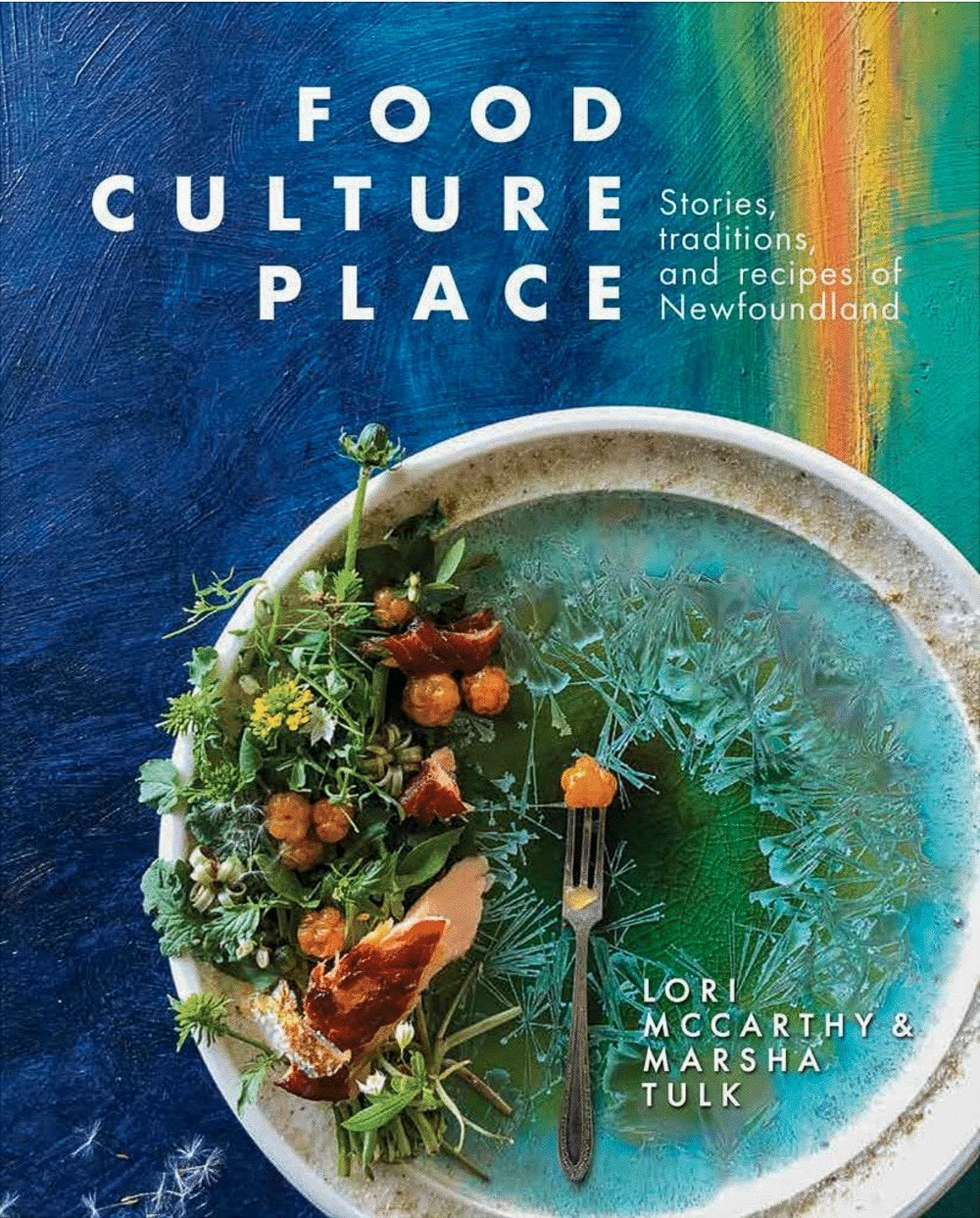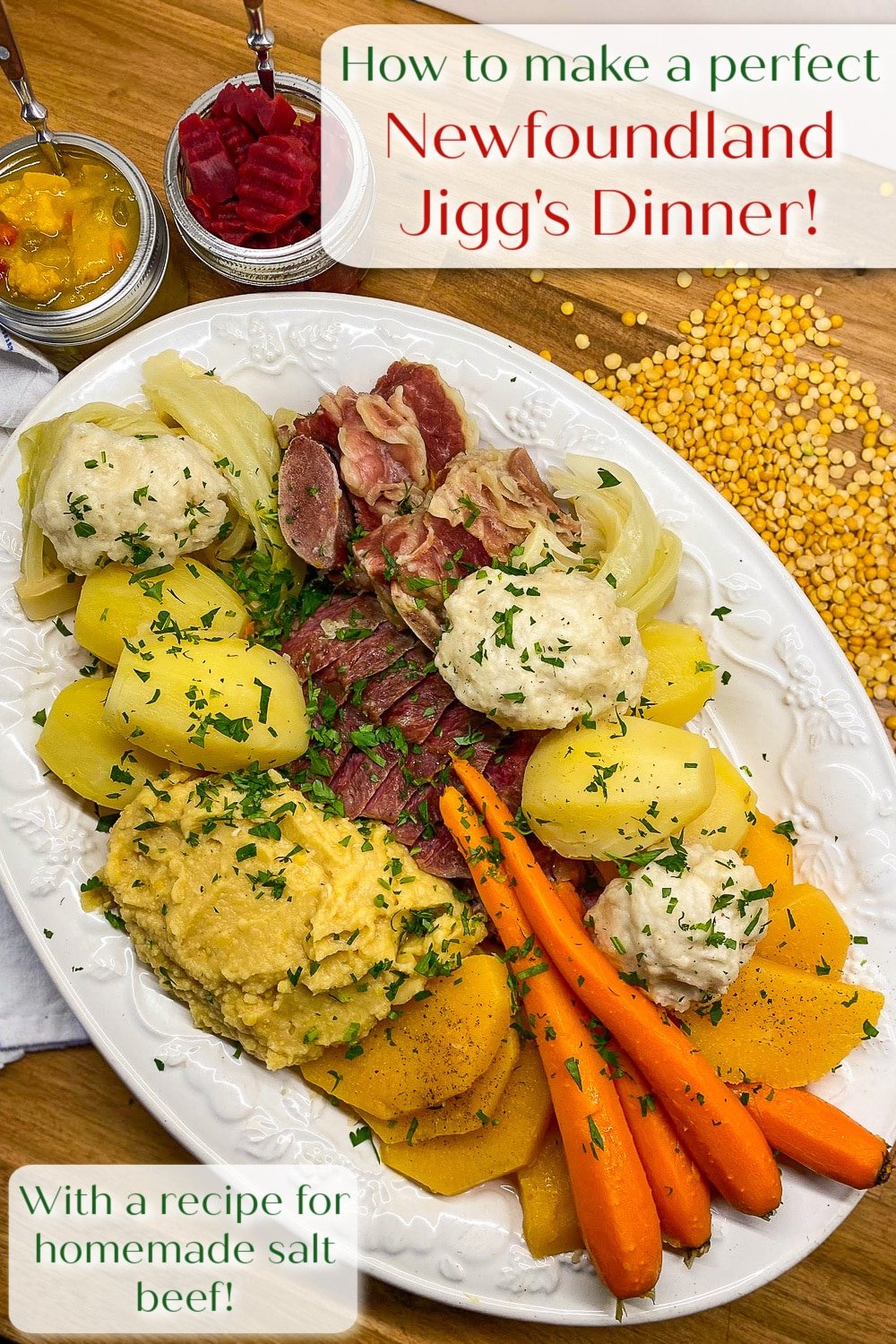Homemade Salt Beef. Newfoundland style. Learn to make your own version of this incredibly popular Newfoundland favorite, that’s a must have for Jiggs Dinner!
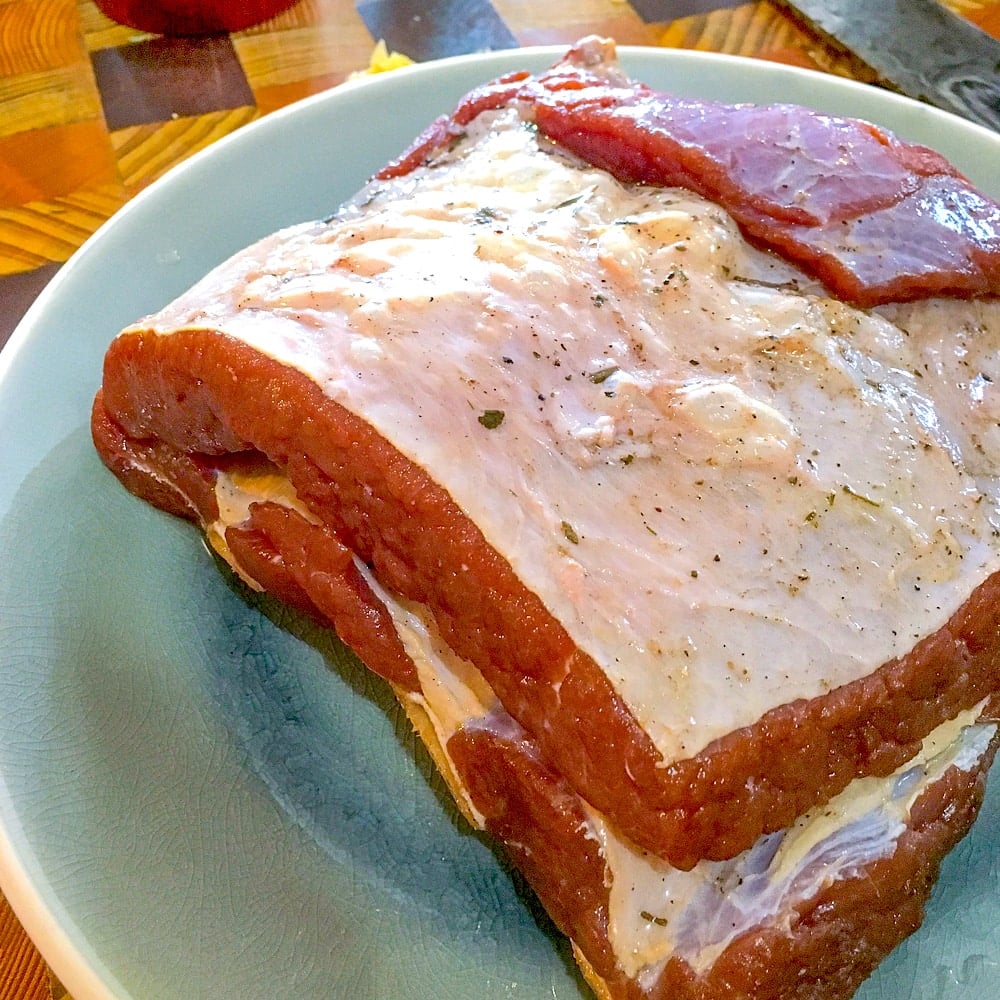
Homemade Newfoundland Style Salt Meat.
Salt beef is a mainstay in Newfoundland cooking. It is found on the side of nearly every sunday roast dinner I have ever had growing up in Newfoundland.
It’s also added for flavour and seasoning in hearty stews and often in place of ham in Newfoundland Pea Soup with Dough Boys.
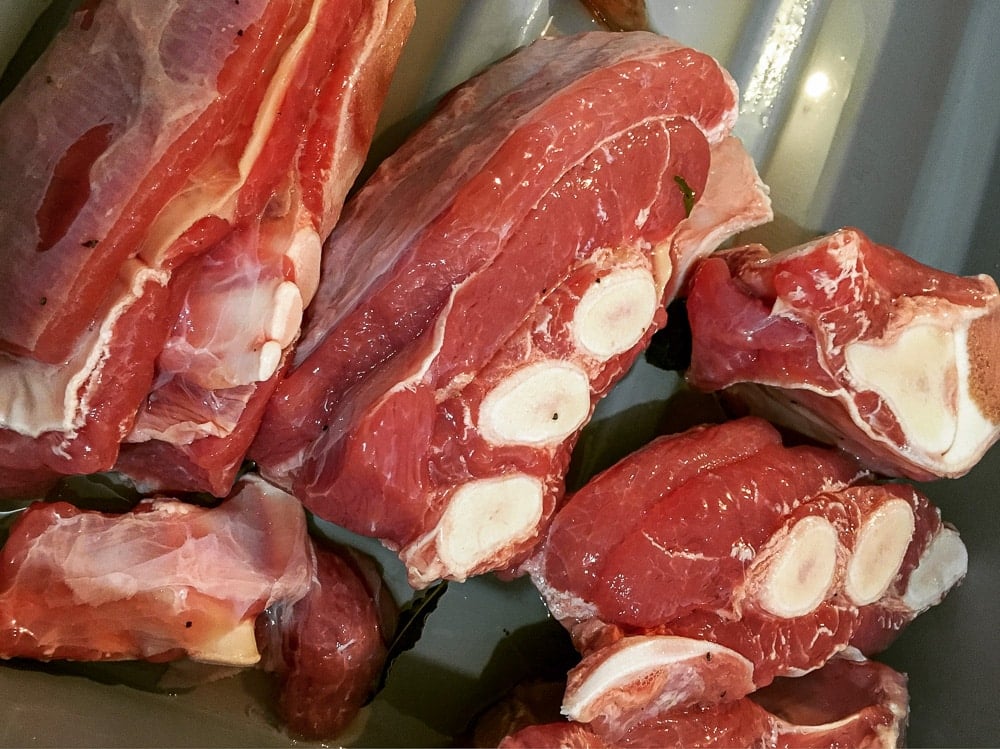
Beef riblets is another good choice for salt meat.
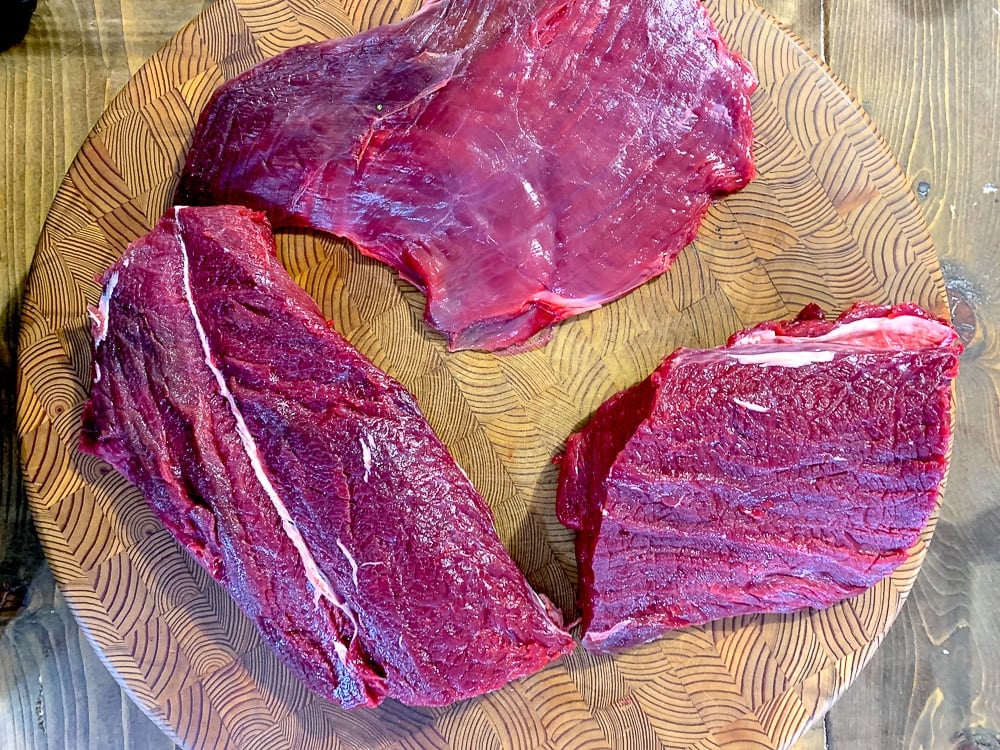
Many tougher cuts of meat can be used in this recipe, even moose or other type venison.
Newfoundlanders all over the world have contacted me to find a homemade version of salt meat. I decided to ask an expert, and someone who has been making their own salt meat for years, to let you all know how it’s done.
In our continuing series of posts from local experts, let me introduce Lori McCarthy, who gives us complete instructions using a variety of cuts, including moose meat!

Lori McCarthy
Along with co-author, Marsha Tulk, Lori is also the author of Food Culture Place. (Amazon link). Both can be found regularly contributing to their own website of the same name as well.
Lori’s recipe includes aromatic ingredients, which I love, to add to the brine mixture if you want but all of these are marked a optional in the recipe.
I do like a couple of tbsp of black peppercorns added at the least, but this is of course, your own choice.
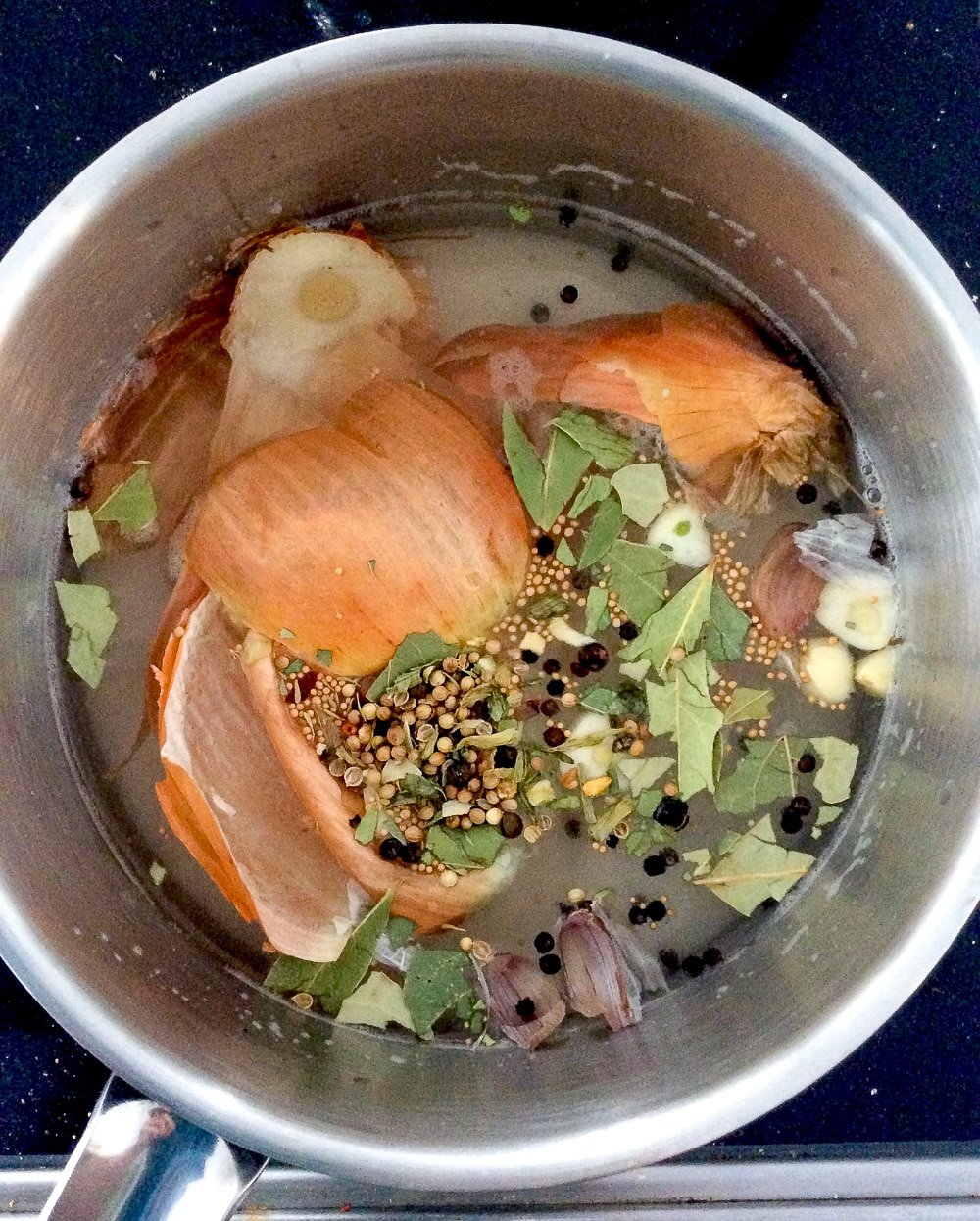
Lori adds aromatic ingredients to the meat brine, but this is totally optional.
Salt Beef by Lori McCarthy
We regularly make our own salt beef and in my opinion it’s always best when you can get beautiful local meat.
If your interested here are a just a couple of places.
(Oliver Farm in Placentia Junction/Haricot Farms in St. Mary’s Bay/New World Beef in Maidstone/Highpoint Farms in Goulds)
We also love to make salt moose and it makes for a great way to use up the tougher cuts of moose and as the Fall is arrives, its a great opportunity to use up any moose that you still have in your freezer from last years hunt 😉
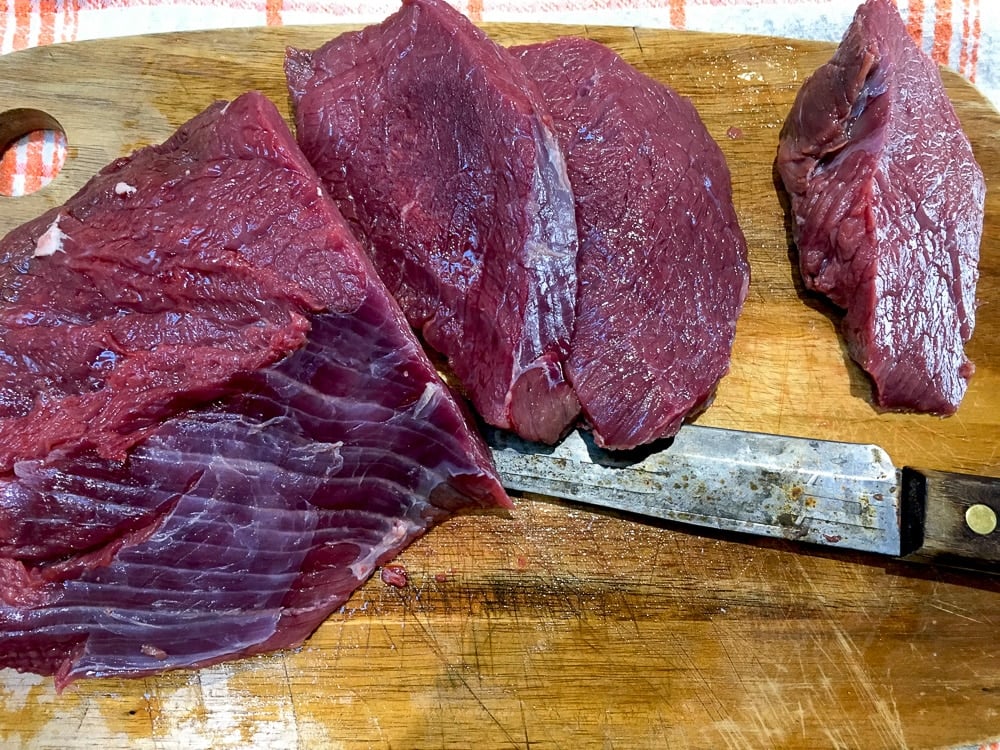
Lean uncooked salt moose meat.
This is not a heavily salted cure, so you get the added benefit of not having to pre-soak it or change the water when it’s cooking. It’s very important to follow the cooking instructions as mom found out when she call me with “ your fadder and I didn’t find it very salty”.
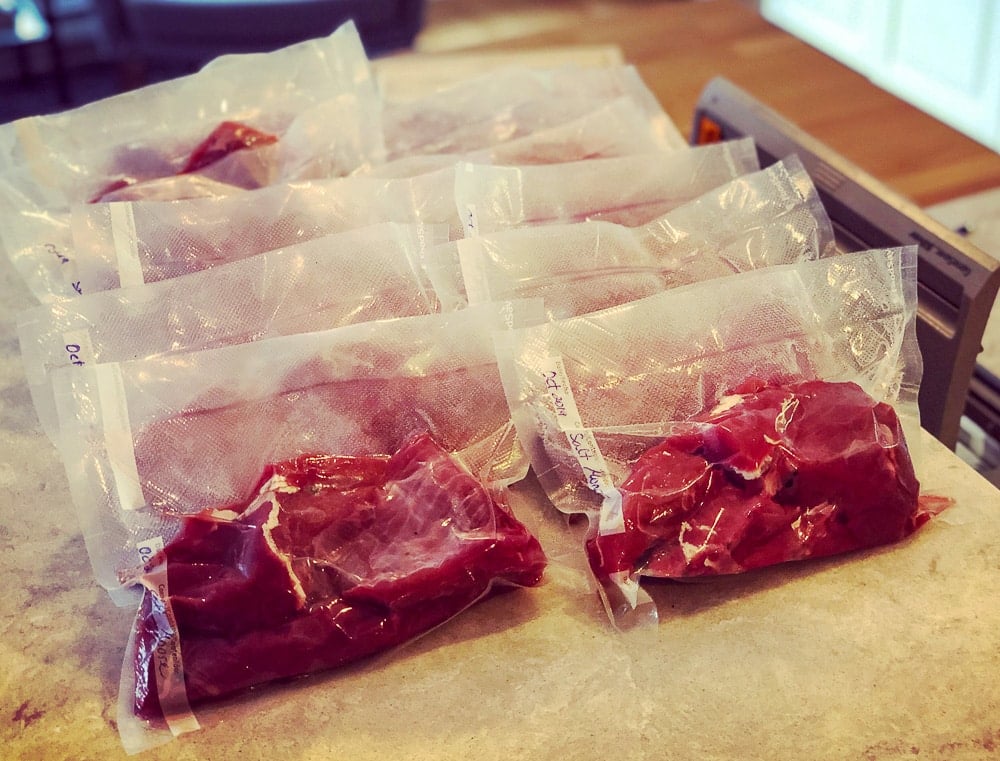
Vacuum sealed salt moose meat. A great lean alternative.
Now lets address nitrates as many people ask all the time about whether to use it, or not to use it. It’s simple, USE IT.
We would insist that you do for two reasons. One is that it gives your meat that nice red color that is synonymous with salt meat and not an unpalatable gray color, don’t forget, we eat with our eyes first.
However the most important reason to add this curing agent is because the salt content in this process is so low the cure is necessary to eliminate the chance of spoilage. This is a safety measure for a low salt curing method.
When you go looking for cure, you are looking for a product that has Nitrite and salt in it. You are NOT looking for Nitrite and Nitrate mix, this product is for dry cures and you’re using a brine or wet cure and this only requires Nitrite and Salt for your brine.
It will often be 94% regular salt and 6% nitrite. The often dye it pink so that you don’t mistake it for your household salt but it’s not always pink.
It will come under several names and could be called, Pink Salt #1, Cure #1, Pink Curing Salt #1, Prague Powder #1. The common theme is that you are looking for a #1 cure and check the ingredients so that it only have salt and nitrite in it.
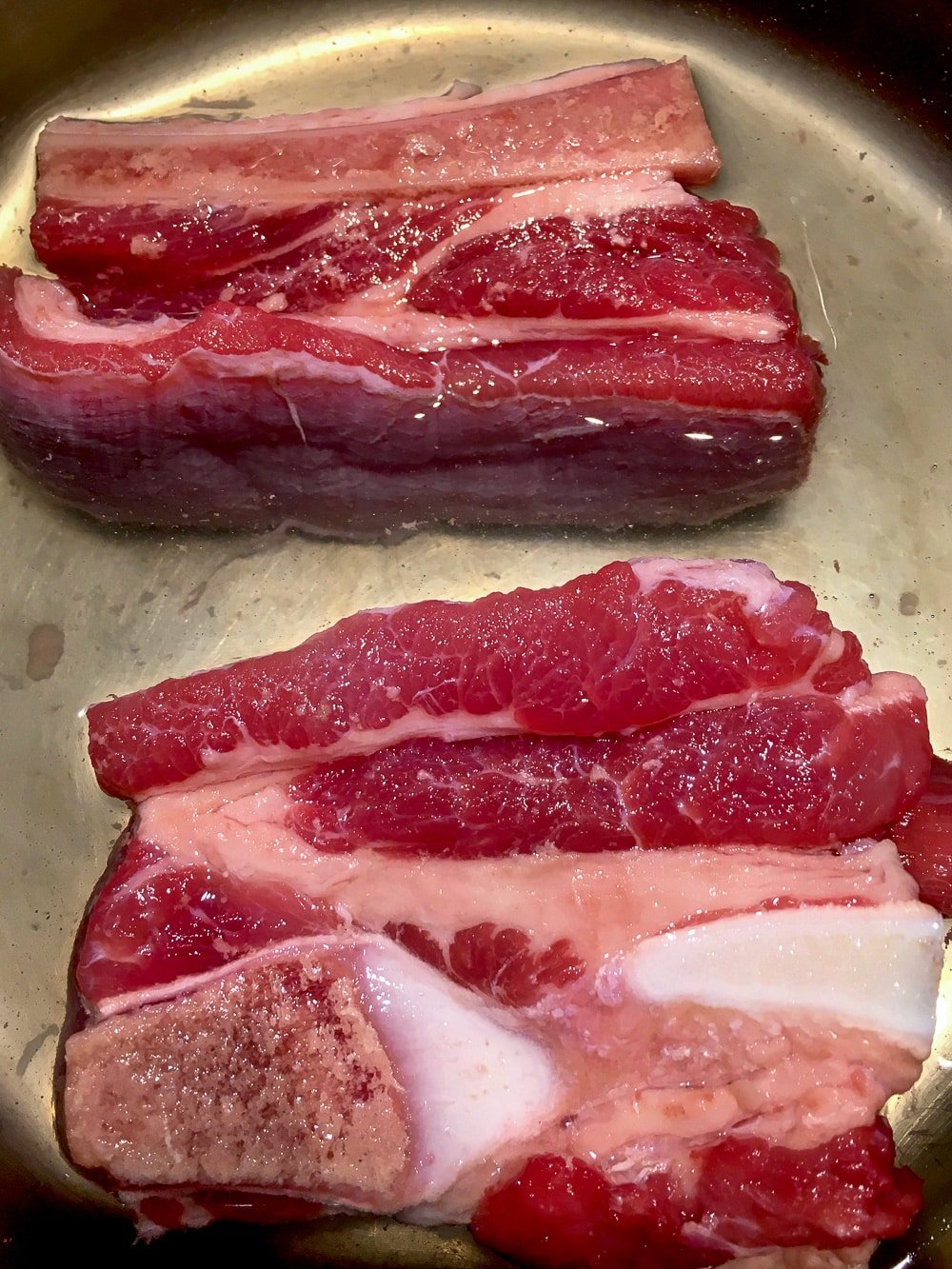
2 pieces uncooked salt beef riblets.
About Lori.
Lori McCarthy identifies fiercely as a Newfoundlander, which means more than just geographical location of birth to her. Her passion for the land is matched only by her passion for food culture.
Deeply rooted here, the skilled chef and outdoorswoman is guided by a sense of responsibility to place. The ethics of conservation and sustainability inform her every move, and she is as serious about protecting Newfoundland culture, resources and food ways as she is about sharing them.
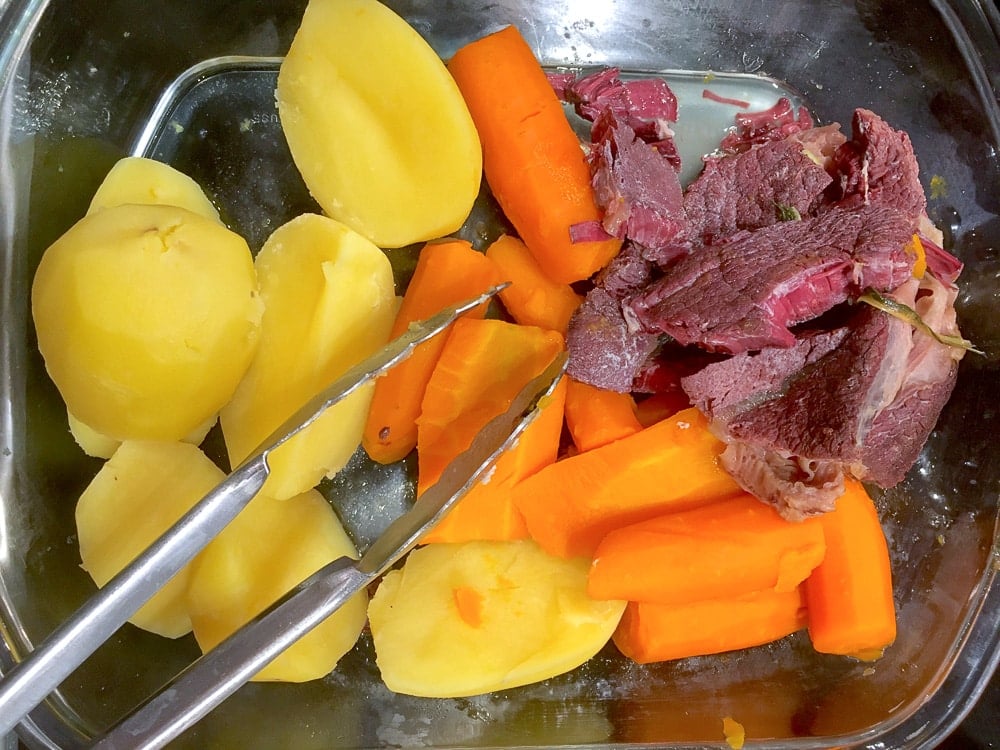
Salt meat with root vegetables. Jigg’s dinner!
To be an innovative chef, forager, hunter, educator , and enthusiastic outdoors person is less unusual amongst Newfoundlanders than you might think. The province’s culture is based on the values of resourcefulness and working with what the land provides.
But Lori has made it her life, becoming a leader and advocate in a back to the land approach where traditional food culture is central. She’s committed to keeping the wild game and foods of this province on our plates for generations to come, and passing on the pride she learned at her own mother’s knee to her own children who will inherit this island’s abundant bounty.
Jiggs’ Dinner!
Since this recipe was first posted, another guest contributor. Chef Mark McCrowe, has added a post for Jigg’s Dinner! His simple guide to making this most iconic of Newfoundland meals.
Be sure to check that out as well by clicking the photo below.
Like this homemade Salt Meat recipe?
If you’d like to see more traditionally inspired recipes from our province, please check out this collection on some of our Most Popular Newfoundland recipes.
Like this Salt Beef recipe?
You’ll find many more traditional and Newfoundland inspired recipes in our Newfoundland section and even more great dishes in our Fish & Seafood Category
It’s easy to keep up with the latest home style cooking & baking ideas from Rock Recipes. Be sure to follow Rock Recipes Facebook Page and follow us on Instagram.
Plus you’ll see daily recipe suggestions from decadent desserts to quick delicious weekday meals too.
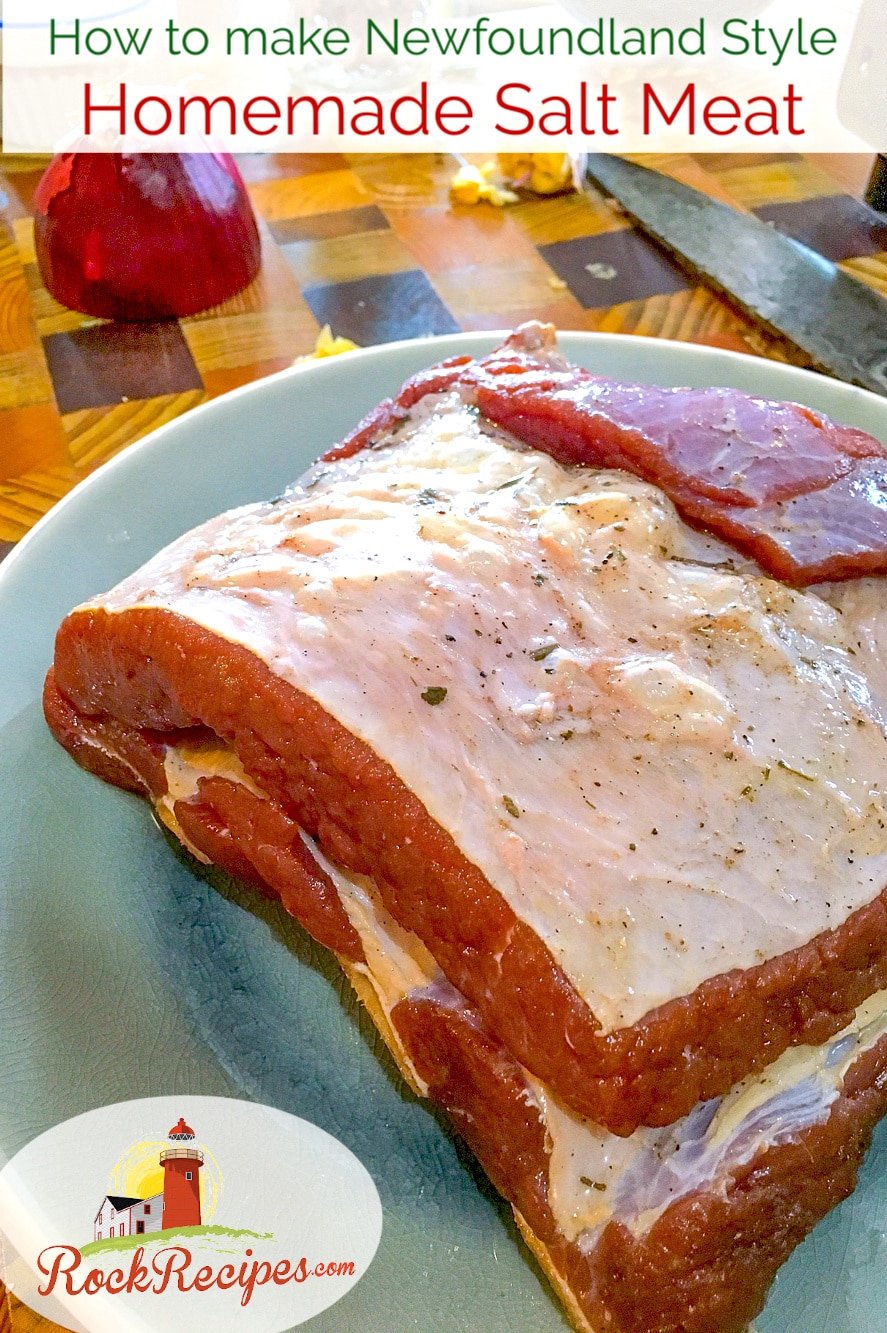
Newfoundland Style Homemade Salt Meat. Copyright Barry C. Parsons. Permalink: https://rockrecipes.com/salt-meat/
You can also sign up for our FREE newsletter to know immediately when we add new recipes. You’ll also get weekly suggestions for great family friendly meals and desserts too!

Rock Recipes a participant in the Amazon Services LLC Associates Program, an affiliate advertising program designed to provide a means for us to earn fees by linking to Amazon.com and affiliated sites. Our product recommendations are almost exclusively for those we currently use or have used in the past.
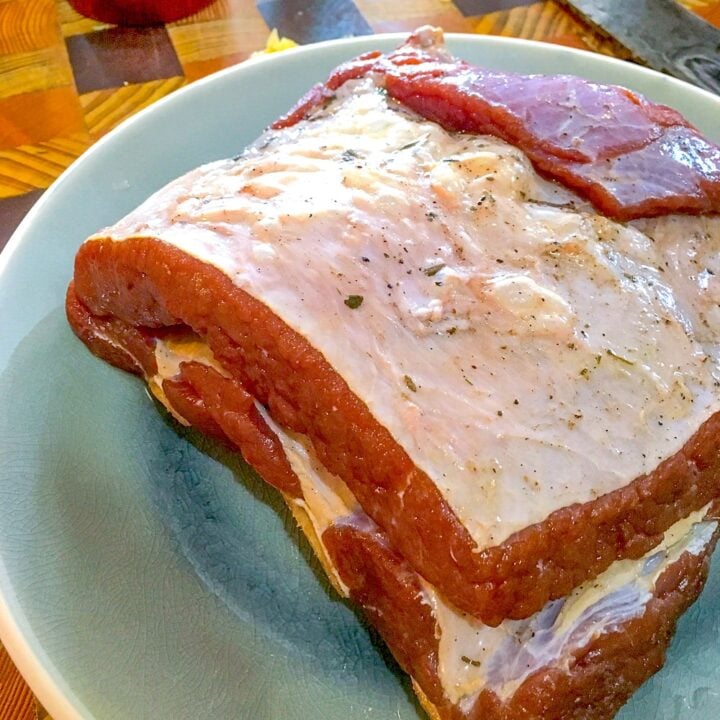
Homemade Salt Beef. Newfoundland style.
Ingredients
- 10 lb locally sourced brisket &/or blade chuck roast, moose etc.
- 1200 g salt, NON-IODIZED. Not table salt. (I use kosher salt)
- 60 g Prague Powder No. 1/Cure #1
- 10 liters water
- 2 tbsp black peppercorns (optional)
- 4 bay leaves (optional)
- 2 onions, chopped in quarters (optional)
- 12 juniper berries (optional)
- 4 cloves garlic, skin on (optional)
Instructions
- To prepare your meat, be sure to slice it so that it is no thicker than 3”thick. If it is less than 3”, say you want to use use steaks, that's absolutely fine. This is very important as your meat will only be in for 10 days and you want it to penetrate all the way through to the center. You don’t want salt meat on the outside and “roast” on the inside!
- Bring to a boil 2 liters of water, add your salt, pepper, bay leaves, juniper berries, onion and garlic . Some of the salt may still not be dissolved but that's ok. Now, add the other 8 ltrs of water and stir until your salt is all dissolved. Add your curing mix. Let cool completely then pour into a large nonreactive container. Once the liquid is fully chilled add your pieces of beef and weigh it down to completely submerge it in the liquid.
- Place the filled container in the refrigerator or outside in a shed or garage if it is cold enough for days. As long as most of the 10 days is below 5 degrees C it’s fine to leave it in the shed. Here in Newfoundland I make it from October to March and leave it outside.
- Give the meat a turn about, every 2 days to redistribute the cure around all pieces of meat for even curing.
- After the 10 days you can cook your salt meat but as long as it’s cold outside the meat can stay in the curing liquid in a cool area for up to 2 months.
- During this time ( 2 months ), you can remove pieces of meat as you need it. To store the meat for longer term, simply pour off the brine, rinse, put in meal size portions in vacuum or zipper type bags and freeze.
- When you are ready to cook just give each piece a good rinse. You do not need to soak this meat like traditional salt meat. It is a very light salt brined so you do not even need to change the water when cooking.
- Place the meat in clean fresh water, just enough to cover the piece by about 3 inches and bring to a boil.
- Turn down and let it gently simmer for 2 to 3 hours until tender. You may need to add additional boiling water while simmering but try to keep the amount of water around 3” above the piece.
- Taste the water a few times and after an hour or so, even taste a little sliver of meat. If it’s too salty for your preference add a few cups of boiling water. Its about learning to taste food and lear your own taste 🙂
- If cooking vegetables with this salt meat as in a traditional Jiggs Dinner, you can add them right on top and add enough additional water as needed.
Using your salt beef
Notes
ABOUT NITRATES
Lets address nitrates as many people ask all the time about whether to use it, or not to use it. It’s simple, USE IT.
We would insist that you do for two reasons. One is that it gives your meat that nice red color that is synonymous with salt meat and not an unpalatable gray color, don’t forget, we eat with our eyes first.
However the most important reason to add this curing agent is because the salt content in this process is so low the cure is necessary to eliminate the chance of spoilage. This is a safety measure for a low salt curing method.
When you go looking for cure, you are looking for a product that has Nitrite and salt in it. You are NOT looking for Nitrite and Nitrate mix, this product is for dry cures and you're using a brine or wet cure and this only requires Nitrite and Salt for your brine.
It will often be 94% regular salt and 6% nitrite. The often dye it pink so that you don’t mistake it for your household salt but it’s not always pink.
It will come under several names and could be called, Pink Salt #1, Cure #1, Pink Curing Salt #1, Prague Powder #1. The common theme is that you are looking for a #1 cure and check the ingredients so that it only have salt and nitrite in it.
OPTIONAL INGREDIENTS
I love that Lori's recipe includes aromatic ingredients to add to the brine mixture if you want but all of these are marked a optional in the recipe.
I do like a couple of tbsp of black peppercorns added at the least, but this is of course, your own choice.
Homemade Salt Beef. Newfoundland style. Learn to make your own version of this incredibly popular Newfoundland favorite, that's a must have for Jiggs Dinner!

